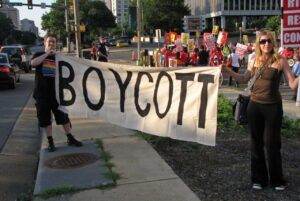Boycott as a weapon of resistance empowers consumers to challenge multinational brands like Starbucks and McDonald’s.
Imagine walking past your local Starbucks or McDonald’s and deciding, “Today, I won’t buy anything here—not because I don’t want to, but because my choice sends a message.” This is the spirit of boycott as a weapon of resistance, wielded by ordinary people against the world’s largest corporations. Boycotts have surged as a form of resistance, especially in response to recent geopolitical crises. But why do they matter? How effective are they? And what lessons can we draw from their history?
Rising Tide of Boycotts
What began as a regional protest quickly went global. As violence escalated, so did public outrage, transcending borders and languages. In the Middle East, the movement found fertile ground, but it didn’t stop there. Europe, North America, Asia, and Africa all saw local activists joining the call to boycott products tied—directly or indirectly—to Israel.
Since the beginning of Israel’s attack on the Gaza Strip in October 2023, calls to boycott companies supporting Israel have increased. With the escalation of Israeli violence and rising numbers of victims, the movement to use boycott as a weapon of resistance has rapidly expanded—not only in the Middle East, but around the world. Graphic images, mounting casualties, and stories of suffering spread across news and social media. This triggered a global call for accountability—not just from governments, but also from companies seen as supporting Israeli policies. The list includes household names like Starbucks, McDonald’s, Zara, and Puma.
What’s behind using Boycott as a weapon of Resistance?
The idea behind a boycott is simple: refusing to buy products from a company, factory, or a specific country, with the goal of collectively forcing a change in that company’s, factory’s, or country’s political or social policies. Boycott campaigns are especially important and influential in regions with significant purchasing power, where boycotting certain products can have serious financial consequences for targeted companies. The broader a company’s business, the more vulnerable it is to the effects of a boycott in different parts of the world.
The main goal? To pressure companies, industries, or even governments to alter their practices or policies. Sometimes, it’s about a single demand—like ending support for a war. Other times, it’s about long-term, systemic change, such as supporting workers’ rights or environmental justice.
A successful boycott needs more than good intentions. It requires public awareness, alternatives for consumers, and a sense of collective purpose. Social media campaigns, viral hashtags, and influential voices can ignite a movement overnight.
Impact of Boycott
The impact and power of a boycott aren’t limited to reduced sales—more importantly, they affect a company’s reputation and brand. Research by Brayden King from Kellogg University found that companies experiencing a decline in public popularity and reputation suffered more damage than those with just a decrease in sales. The greater the media attention on the boycott, the more significant its impact.
King’s study shows that the effect of a boycott on a company’s reputation or public image is often much greater than the drop in its sales. This is exactly what the boycott movement aims for—and it’s what most concerns the managers of these companies.
Moreover, The more media attention a boycott receives, the greater its impact. The “echo effect” in today’s digital world can turn a local action into a global movement overnight, multiplying the pressure on companies to respond.
Is it effective to use Boycott as a weapon of resistance?
The University of Kansas’s “Effective Advocacy” guide references a 1991 survey in the UK, which found that company managers considered boycotts more effective than pressure campaigns or group actions in prompting reforms. The guide also highlights the importance of setting realistic, long-term goals alongside short-term ones.
According to Cesar Chavez, who led the grape growers’ boycott in California in the 1960s, a boycott needs to convince about 5% of consumers to join for it to have a tangible effect. If it reaches 10%, the impact can be devastating. However, research also suggests that in some cases, it is not the actual loss of sales but simply the threat to a brand’s reputation that achieves the goals of a boycott as a weapon of resistance.
For a boycott to be sustainable and achieve its goals, appropriate alternatives with similar or lower quality and price must be offered. In campaigns against imported goods, consumers often turn to domestic alternatives. In such cases, boycotts can not only achieve political and social objectives, but also benefit the local economy.
Importance of Alternatives
While using boycott as a weapon of resistance, it can last longer depending on having suitable alternatives. When imported goods are boycotted, consumers often turn to local products—benefiting domestic economies while supporting the boycott’s objectives.
From McDonald’s to Puma
McDonald’s: Backlash and Continued Boycott
McDonald’s faced its own storm after its Israeli branch announced free meals for Israeli troops. Despite attempts by regional franchises to distance themselves and even pledge donations to Gaza, public anger persisted. In the Middle East, foot traffic plummeted, and even months later, the boycott’s sting remained.
Starbucks: A Costly Stand
Starbucks faced one of its worst crises after it sued a workers’ union for posting “Solidarity with Palestine” on social media. The backlash was immediate—hashtags like #boycottstarbucks trended worldwide, and millions pledged to avoid the brand. The result? A massive drop in market value and long-term damage to its brand image.
Zara: Advertising Missteps and Global Outrage
Fashion giant Zara became a boycott target after an ad campaign seemed to mock the suffering in Gaza, featuring models with props resembling coffins and rubble. Even after pulling the ads and calling it a “misunderstanding,” the damage was done—protests erupted, and sales took a hit.
Marks & Spencer and Puma: The Broader Sweep
British retailer Marks & Spencer drew ire after a perceived insult to the Palestinian flag, leading to widespread condemnation and boycotts. Sportswear company Puma, meanwhile, was pressured into ending its sponsorship of the Israeli basketball team after relentless activism and protests.
Social Media: Catalyst for Modern Boycotts
Today’s boycotts look different from those of the past. Dedicated websites now track which brands are targeted, and apps let users scan product barcodes in-store to see if a purchase aligns with the boycott. This tech-savvy approach makes it easier than ever for consumers to act on their values.
In this way, the boycott as a weapon of resistance is more accessible and coordinated than ever before.
Why Boycotts Matter Beyond Economics
At their heart, boycotts are about more than money—they’re about ethics, dignity, and solidarity. When people collectively refuse a cup of coffee or a hamburger, they’re taking a stand against injustice. The act may seem small, but multiplied millions of times, it sends a message that can’t be ignored.
Conclusion
The movement to boycott companies like Starbucks and McDonald’s isn’t just a reaction—it’s a statement. It’s proof that ordinary people, when united by a cause, can shift the strategies of billion-dollar brands. This outcome emphasizes how the boycott as a weapon of resistance can force even major international brands to reconsider their partnerships and policies in response to widespread consumer activism. While the economic impacts are real, it’s the moral and reputational costs that leave the deepest scars. As long as injustice persists, boycotts will remain a vital tool of resistance, reminding us all of the power we hold every time we choose where to spend—or not spend—our money.
FAQs
1. What is the main goal of a boycott?
The main goal is to pressure a company or government to change its policies or actions by withholding financial support.
2. How do boycotts impact major companies?
Boycotts can lead to financial losses, damage to brand reputation, and can even force changes in corporate behavior.
3. What are the challenges in maintaining a boycott?
Keeping public interest high and providing alternatives to boycotted products are key challenges.
4. Are boycotts always effective?
Not always, but even when sales aren’t heavily affected, boycotts often succeed in damaging a company’s reputation and raising awareness.
5. How can individuals participate in a boycott?
By avoiding targeted products, spreading the word, supporting alternatives, and using tools to stay informed about which brands are included.




